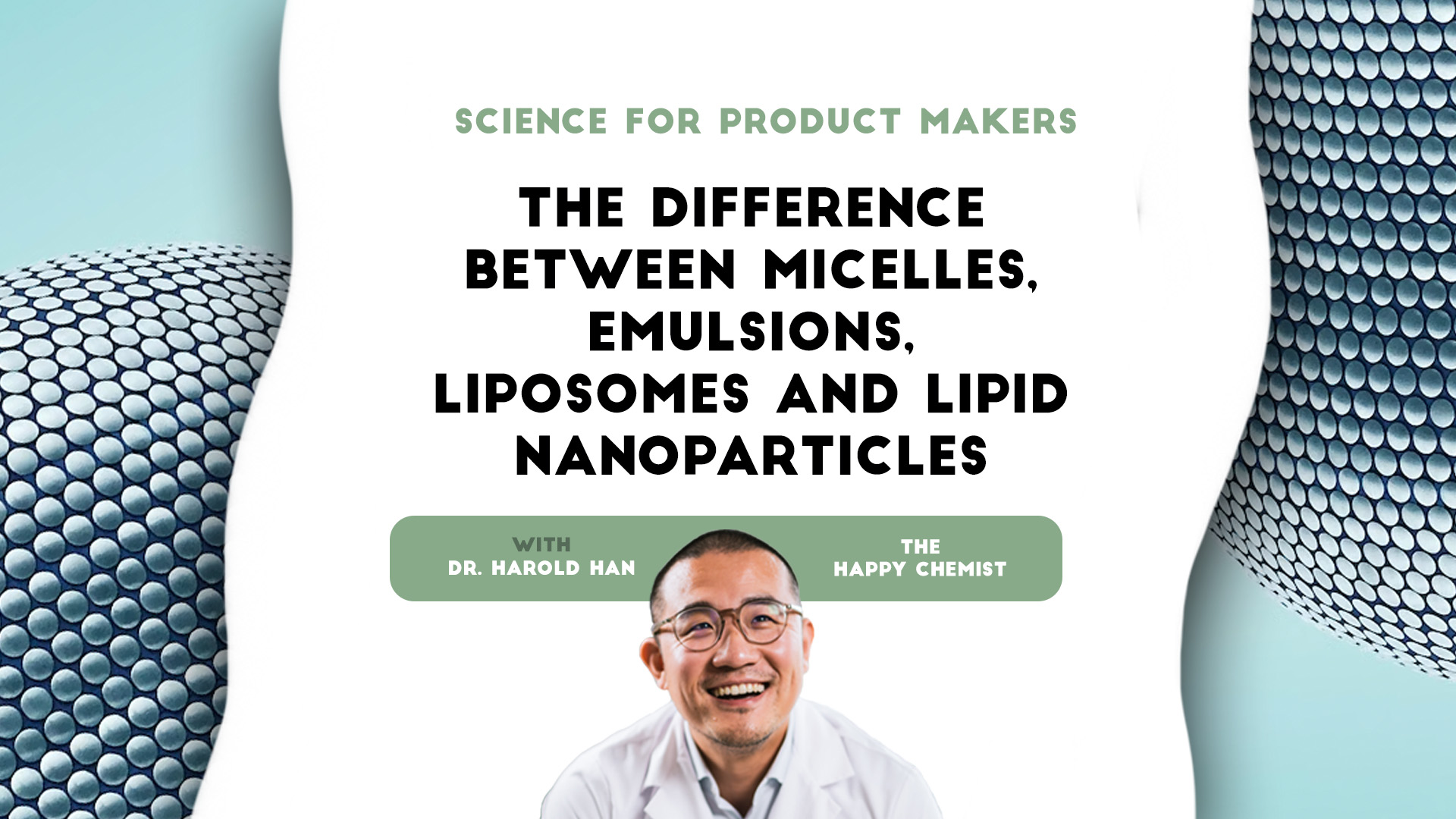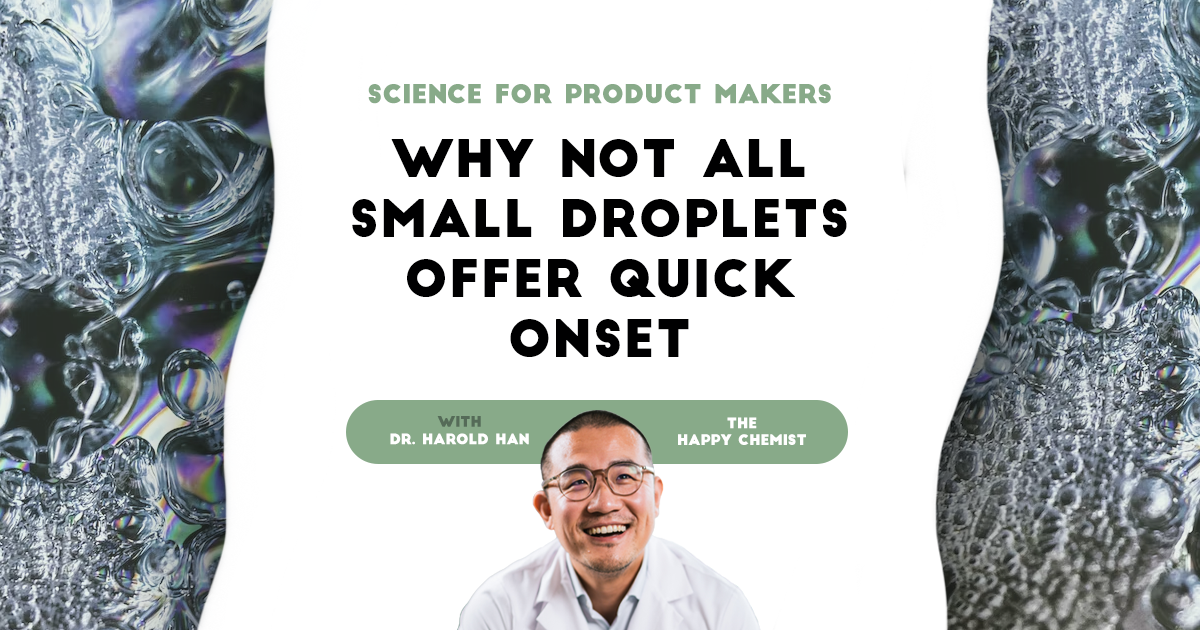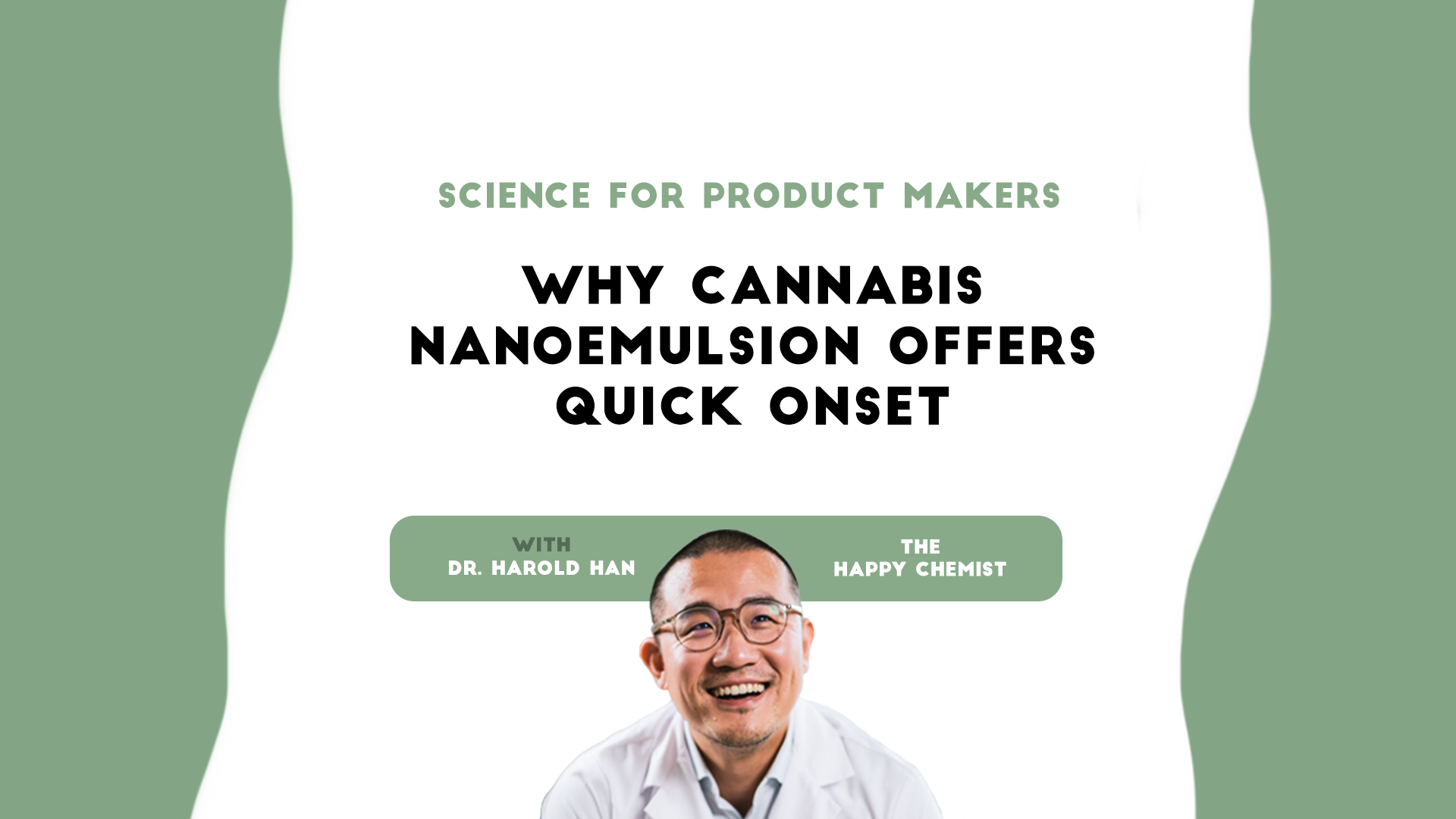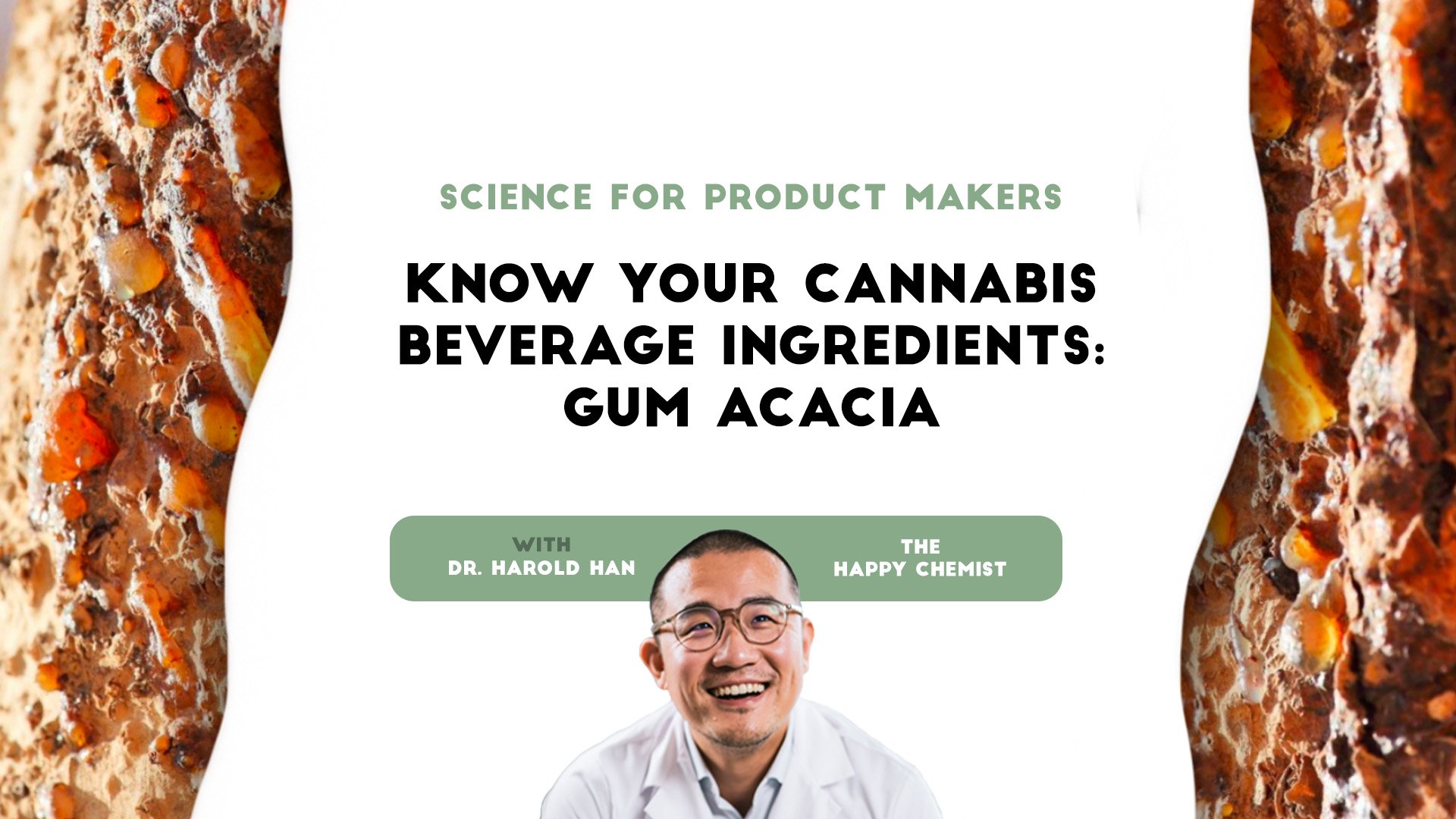Science for product makers: Why not all small droplets offer quick onset
This post is also published as an article on Harold's LinkedIn profile. You can read and leave comments here. Inmy last post, we learned that a...
4 min read
 Dr. Harold Han - "The Happy Chemist"
:
6/28/24 5:19 PM
Dr. Harold Han - "The Happy Chemist"
:
6/28/24 5:19 PM

This post is also published as an article on Harold's LinkedIn profile. You can read and leave comments here.
Since cannabinoids are not soluble in water, the growth of the cannabis beverage industry has pushed the need for technologies that deliver hydrophobic molecules in aqueous applications. Micelles, emulsions, liposomes, and lipid nanoparticles have become key discussion topics among product makers.
Each of these form factors has its own features and designated applications. And not all technologies are equally effective in delivering cannabinoids in beverages.

I conducted a poll on Linkedin and overwhelmingly, people selected lipid nanoparticles as the most efficient method to deliver oil soluble actives. The correct answer, however, is emulsions (or nanoemulsions). Let me explain.
Before diving in, we need to align on what an emulsifier is. Emulsifiers (also called surfactants) typically have a hydrophilic (water-loving) part and a hydrophobic (oil-loving) part. These molecules tend to adsorb where oil and water meet. They orient themselves by their chemical affinity, meaning that the hydrophilic side reaches towards the water, and the hydrophobic side reaches towards oil (see Fig. 1). By doing this, they lower the energy between oil and water, coating the oil droplet with a hydrophilic outer layer, making the droplets water compatible.

Fig. 1 Basic emulsifier structure and its orientation at an interface between oil and water.
Micelles, emulsions, liposomes, and lipid nanoparticles all leverage emulsifiers to stabilize the systems — they are just designed differently.
Micelles are usually formed by emulsifiers spontaneously self-assembling. They are usually very small (2-20 nm) clusters consisting of hydrophilic heads facing outside (in contact with water) and hydrophobic tails facing inwards (not in contact with water). Figure 2 shows the formation of a micelle.

Fig. 2 Micelle formation
Efficacy: Micelles’ small droplet size is a double-edged sword: on one hand, they do not scatter light strongly, which means they tend to form transparent solutions. But on the other hand, micelles can usually only incorporate a relatively small amount of hydrophobic material (such as THC) in their hydrophobic cores, which makes them inefficient in delivering cannabinoids in a beverage application. People can still make it work by creating much higher numbers of micelles to compensate for its small individual capacity, but it would use an excessive amount of synthetic emulsifiers. Not the best approach considering label claim and flavor.
When the ratio of oil, water and emulsifiers are optimized, external energy (e.g. sonication or high pressure homogenization) can be introduced to break up the system and create new surface area. This leads to the formation of an oil-in-water emulsion, where the oil droplets are coated by a layer of emulsifiers to make it water-compatible (see Fig. 3). The type and amount of emulsifier should be carefully designed to protect the droplets in the environment they exist within a product's lifetime.

The size of the emulsion droplet can range from 50 nm up to micrometer levels, which is determined by a combination of chemistry (ingredient type & amount) and physics (energy type & amount). You can learn more about the two major types of emulsion — nanoemulsions and microemulsions — in my previous post.
Efficacy: At the moment, emulsions are the dominant technology powering cannabis beverages. Their key advantages are:
Liposomes are often misused in our industry given its good sounding name for marketing purposes.
Liposomes are produced by naturally derived emulsifiers called phospholipids, which are usually obtained from soybeans, sunflower, egg yolk, milk, or marine organisms. As shown in Figure 4, phospholipids have one hydrophilic (water-loving) head and two hydrophobic (oil-loving) tails. They naturally form a bi-layer structure with the tails hiding inwards and the heads sticking outwards.
Using special fabrication techniques, this bi-layer structure can curve and form a sphere known as a liposome. Due to the curvature, the liposome has a very special structure with an outward-facing hydrophilic layer, a hydrophobic layer in the middle and a hydrophilic core inside (see Fig. 4).

Fig. 4 Formation of a liposome
Efficacy:
Liposomes are mainly designed to deliver water-soluble molecules, which are delivered in the inner core.
Hydrophobic drugs (like THC) can also be solubilized within the hydrophobic middle layers between the tails of the phospholipids. However, compared to emulsions, liposomes have a limited capacity to encapsulate oils. It is easy to increase the size of the hydrophilic inner core to deliver a higher amount of water soluble actives. However, when the size of the liposome increases, the volume of the hydrophobic bi-layer remains similar, which does not help deliver more hydrophobic active (like THC) (see Fig. 5). This limits liposome's application in cannabis beverage application.

Solid lipid nanoparticles (SLN) have the same structure as emulsions, but the oil centers are solid rather than liquid. This is produced by manipulating temperature and phase change of the lipid material. Take beeswax for example: it melts into liquid at high temperature but solidifies when cooled. When beeswax is used as the oil phase, emulsification happens at high temperature and solid lipid nanoparticle forms when the temperature cools down.
Efficacy: Solid lipid nanoparticles are usually used in the pharmaceutical industry where the solid core protects the hydrophobic drug until it is delivered to the target organ. They can potentially be used to deliver cannabinoids in a beverage application, but the cannabinoids release rate from this solid core may be lower. I encourage more research to compare the pharmacokinetics/ pharmacodynamics between a cannabis lipid nanoparticle and cannabis nanoemulsion.

Fig. 6 Visual comparison of micelle, liposome, nanoemulsion droplet and lipid nanoparticles.
Since the core material of a lipid nanoparticle is solid, there is an ongoing industry concern around the biological fate of the particles upon consumption. In the next post, I will explain in more detail about the difference between nanoemulsions and nanoparticles.

Table 1 Summary of properties between different colloids.
Micelles, emulsions, liposomes, and solid lipid nanoparticles are different methods we can leverage to infuse cannabis into beverages. They are all emulsifier-based technologies and their main differences come from how the chemistry (ingredient / ratio) is combined with physics (energy input). Figure 6 and Table 1 offer visual comparison.
Micelle, liposome and lipid nanoparticles are not yet proven to deliver cannabinoids in a beverage application efficiently and effectively.
In the current cannabis beverage industry, emulsion is proven to be the dominant delivery technology (although being an emulsion chemist myself, I admit I may have a personal attachment). But we should always keep innovating to discover newer and better technologies.

This post is also published as an article on Harold's LinkedIn profile. You can read and leave comments here. Inmy last post, we learned that a...

This post is also published as an article on Harold's LinkedIn profile. You can read and leave comments here. Our industry generally agrees that...

This post is also published as an article on Harold's LinkedIn profile. You can read and leave comments here.